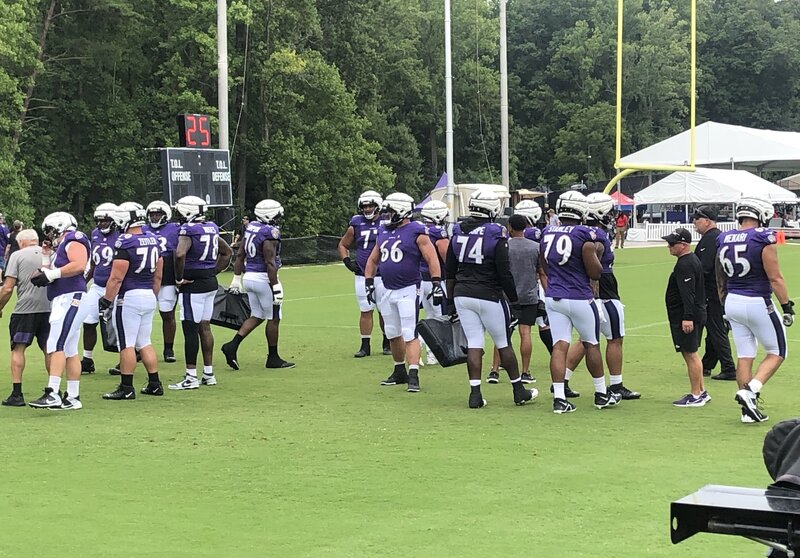The Ravens had a clear objective at the start of free agency, even if it wasn’t exactly what many expected.
Yes, work remains to replace eight-time Pro Bowl right guard Marshal Yanda, add an inside linebacker, strengthen the pass rush, and find a impact pass-catching option or two, but general manager Eric DeCosta recognized a problem that became painfully clear in the stunning 28-12 playoff loss to Tennessee. The Ravens surrendered the fourth-highest rushing total in team history on that disappointing January night, but warning signs were there long before Derrick Henry and the Titans piled up 217 rushing yards on 37 carries, a 5.9 yards per carry average.
The Week 4 debacle against Cleveland prompting the on-the-fly retooling of the defense was one thing, but the strong December rushing performances by San Francisco and Buffalo couldn’t be dismissed simply because of a strong effort the second time around against the Browns in Week 16. Something wasn’t quite right with an area often championed as the Ravens’ greatest strength over the last two decades.
We’ve long been programmed to look at volume, which painted a rosy picture for the run defense. The Ravens ranked fifth in the NFL at just 93.4 rushing yards allowed per game as opponents ran a league-low 340 times against them. But Baltimore ranked just 21st at 4.4 yards per carry allowed — easily the worst single-season mark in team history — and allowed 4.54 yards per attempt if you include the playoffs. Football Outsiders ranked the Ravens only 19th in its run defense efficiency metric known as DVOA, which compares success on every single play to a league average based on situation and opponent.
Hopefully, we’ve learned by now that conventional teams run the ball more because they’re winning — not the other way around. That’s why opponents were rarely able to take advantage of Baltimore’s relative weakness.
The Ravens won a lot and by significant margins in 2019, registering the highest regular-season point differential (plus-249) the NFL had seen since the 2007 New England Patriots. Nine of their 14 victories were by 14 or more points as league MVP Lamar Jackson and a record-setting offense shredded teams on a near-weekly basis, often making opposing ground attacks irrelevant.
But after the acquisitions of defensive linemen Calais Campbell and Michael Brockers this week, DeCosta’s recent comments that seemingly prioritized a better pass rush prompted a different perspective.
“If our offense continues to play at the level they played at this past year, we will probably be ahead in some games and we’re going to want to have a strong pass rush,” DeCosta said at last month’s scouting combine in Indianapolis. “I think on defense, if you look at great defenses, historically three things: can rush the passer, can cover, and can stop the run. We really do believe all three of those things are really important. We’re trying to build a defense that can do all three of those things.”
What if the offense doesn’t play at quite that same level though?
That’s not to predict gloom and doom for Jackson and the Ravens by any means, but they’re more likely to experience at least a little regression toward the mean than to match or break the slew of league and franchise records set by last year’s group. What the Ravens offense did last year was extremely rare and shouldn’t be taken for granted.
In the 12 games (postseason included) in which the Ravens either trailed at some point or held only a single-possession lead for a portion of the second half, the defense surrendered just over 4.7 yards per carry. A few of those games still ended in comfortable victories, mind you, but it speaks to how well opponents were able to run when they didn’t have to abandon the ground game or weren’t simply playing out the string in an embarrassing defeat.
According to Pro-Football-Reference, the Ravens allowed a whopping 6.1 yards per carry on 53 attempts when trailing in games. That’s not a very big sample, of course, but it again illustrates the vulnerability when opponents were able to lean harder into the ground game.
In planning for 2020, DeCosta couldn’t assume his offense would hide the run defense quite as effectively, making it important to improve the defensive line. Enter Campbell and Brockers — regarded as two of the best run-stopping defensive linemen in the league — as upgrades to Chris Wormley and Michael Pierce, who didn’t have standout seasons in 2019. Like Sam Adams and Tony Siragusa 20 years ago, the presence of these newcomers along with Brandon Williams should make life easier for anyone playing inside linebacker in 2020.
A five-time Pro Bowl defensive end with 88 career sacks in 12 seasons, the 6-foot-8, 300-pound Campbell is the most versatile defensive lineman to play for the Ravens in years, providing a major boost to both their run defense and pass rush. Campbell may not be the conventional edge defender many coveted, but his ability to stop the run and pressure the pocket from multiple spots along the defensive line makes him a valuable chess piece for defensive coordinator Wink Martindale, who used extensive dime and nickel packages last season.
“Calais is a player we have long admired, even going back to the draft when he came out of college,” DeCosta said in a statement released Thursday. “He’s a natural fit for our defense and a versatile player who plays like a Raven.”
With much of the outside focus at other positions, DeCosta spending big on two defensive linemen reinforced that old Ravens staple of stopping the run, something with which the 2019 defense struggled despite the overwhelming team success. With more thump and resistance up front, DeCosta can now shift his attention toward augmenting the defense’s second level at both inside and outside linebacker.
That way, even if the offense isn’t quite on the historic level of last year, a more complete Ravens defense will be ready to shut down the run.











